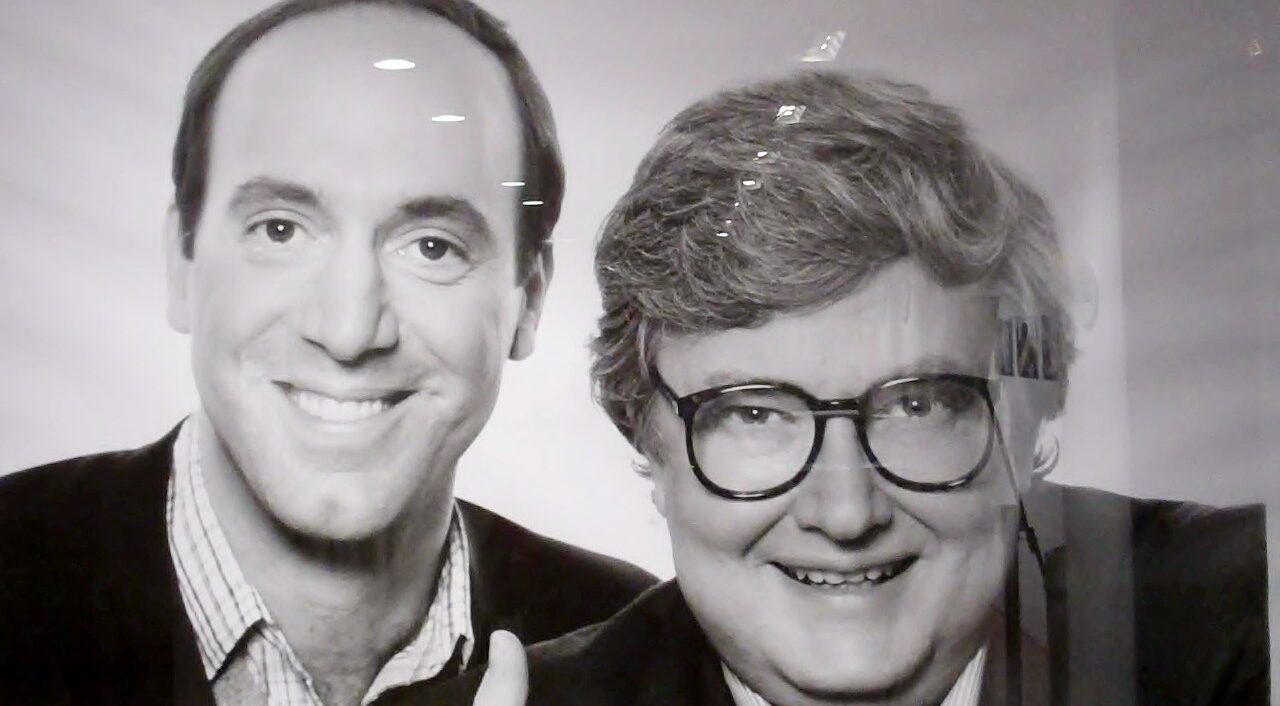Decline and Fall, Hollywood Style
From TAC’s Bookshelf: A new book examining the pop-culture equivalent of Firing Line shows how far movies have fallen.

Opposable Thumbs: How Siskel & Ebert Changed Movies Forever, by Matt Singer, G.P. Putman’s Sons, 342 pages.
As a film lover who came of age in the 1990s and early 2000s, I relied on a wide range of critics for insight and illumination. I read Andrew Sarris for his guidance on directors, Jonathan Rosenbaum for his depth and breadth, Stanley Kauffmann for writerly elegance, and John Simon for writerly vitriol.
When I simply wanted to determine what to see, though, I turned to a less prestigious but no less valuable subcategory of writers: critics employed by daily newspapers. Among the heralds who spoke of what was worth seeing or not seeing any given week, my own favorite was Janet Maslin of the New York Times, but the most famous were undoubtedly Gene Siskel and Roger Ebert.
Both worked for newspapers—Siskel, the Chicago Tribune, Ebert, the Chicago Sun-Times—but like most of the rest of the world, I was familiar with them primarily through T.V.: Their much-loved movie review program, Siskel & Ebert, had been transmitting cinephilia over the airwaves in assorted iterations since 1975 and was still, by the time I first encountered it in the mid-’90s, a fixture in syndication.
Even back then, I considered Siskel and Ebert to be more akin to consumer guides than real, live critics, but since I did not have unlimited time to see new releases, it would be a lie to say that I did not rely on their guidance sometimes. I put greater stock in raves that were unexpected than raves that followed consensus. If either critic commended an unlikely film with particular zest—as was the case with three favorites of mine from that era, James Ivory’s A Soldier’s Daughter Never Cries, Woody Allen’s Everyone Says I Love You, and Paul Thomas Anderson’s Hard Eight—I was likely to buy a ticket. On the other hand, when one or both of them disparaged a film I was otherwise interested in seeing (say, David Lynch’s Lost Highway), it did not stop me from proceeding with my plans.
The success of the consumer-guide format, however, depends on a steady stream of variable products about which to issue guidance. In other words, the available supply of movies must consist of both good ones and bad ones—not all bad ones. Around the turn of the millennium, the center still held: major film artists were still in our midst—Kubrick, Altman, Lumet—and there was always the chance that even a fairly pedestrian studio product might be worth seeing for its craftsmanship or humanity. Even seemingly routine commercial efforts like The Fugitive, Donnie Brasco, or My Best Friend’s Wedding—all of which both Siskel and Ebert endorsed—might have unexpected notes of expressiveness. These days, however, the medium is so dominated by obviously obnoxious content—movies based on comic books, movies based on toys or dolls, movies that function like video games—that we scarcely need a consumer guide to direct us to the few outliers.
For this reason, Matt Singer’s exhaustive, loving paean to Siskel and Ebert and their show—Opposable Thumbs: How Siskel & Ebert Changed Movies Forever—has the feeling of an elegy. In part, that’s because of the unhappy fates of its subjects. Both men were struck down by cancer: Siskel died of brain cancer in 1999, and Ebert, following a brutal bout with thyroid and jaw cancer, in 2013. If they were alive today, the odds are that their show would not dispense advice so much as state the obvious: We don’t need to be told that The Fabelmans is better than the Aquaman sequel.
Yet during the period when Siskel & Ebert dominated the national conversation on movies—and let us pause to remember how ubiquitous their “Two Thumbs Up” designation was in movie advertising—good movies were made as often as poor ones, and a show that helped audiences tease out the difference proved most useful.
In a series of swift, well written chapters, Singer sketches the early years of his subjects. Ebert was a journalism junkie who would have been happy being a columnist on the order of Mike Royko. His advancement to the ranks of chief film critic at the Sun-Times was entirely attributable to his youth: After his predecessor, Eleanor Keen, retired, the paper was receptive to a wet-around-the-ears critic who could help explain to readers the appeal of groundbreaking pictures like Bonnie and Clyde. By the same token, Siskel put himself forward as the permanent replacement to Tribune critic Clifford Terry—a bold move consistent, in Singer’s telling, with Siskel’s lifelong self-confidence and willingness to take gambles on himself.
Each man settled into their roles as newspaper critics—Ebert even won a Pulitzer Prize for his elegant, companionable reviews—but when greatness was thrust upon them in the form of a T.V. pilot, the results weren’t pretty. “Roger and Gene had each worked in television prior to Opening Soon, but you wouldn’t know it from their performance,” Singer writes, referring to the title of the pilot program.
Their incompetence was hard to conceal for years thereafter. On the initial public-television version of the show, the hosts appeared “lethargic, uncomfortable, and sometimes downright bored,” Singer writes. They wore bad 1970s-era attire—“loud patterns, cream-colored turtlenecks, and massive lapels”—and rigidly adhered to their scripts. Things improved once repeated takes were ditched, off-the-cuff argumentation was embraced, and its hosts wore better clothes. In other words, Siskel & Ebert, at its best, became a pop-culture equivalent of Firing Line. One especially nifty detail included here: the show added to its authenticity by ending with shots of its hosts still chatting, or debating, even as the credits came up. “It suggested these guys would be talking whether there were cameras present or not,” Singer writes.
The book winds through the various milestones of the show. We learn about the hosts’ appearances on David Letterman and Johnny Carson, their relationship with the program’s eventual parent company, Disney, and their unceasing rivalry with each other, which would sound contrived were it not for the evidence provided in old episodes of Siskel & Ebert: When one of them disagrees with the other, the ensuing fireworks feel real.
Singer makes much of aspects of the show that were once unique but have long since become ordinary. For example, back in the ’70s and even into the ’80s, clips from films under review could only be seen in the context of their reviews; it was literally impossible to view extended scenes from a new release anywhere else. He also makes the point that Siskel and Ebert’s approach to rating movies—thumbs up, thumbs down—has been coopted by the public at large. Anyone who has rated a product on Amazon or the restaurant is performing the same role.
None of this suggests that, even if Siskel and Ebert had lived longer lives, their show would have lasted. This is not mere speculation: The assorted successors anointed to take over the show after Siskel’s death and Ebert’s illness all failed to resonate, and not just because they lacked their predecessors’ magic.
The simple truth is that the movies are just not as good as they were when Siskel and Ebert were opining on the airwaves. Singer acknowledges this early in the book: “A critic is only as interesting as the movies they have to write about,” he writes, referring to the critics’ early newspaper days, “and in the late 1960s there were an awful lot of good movies to discuss.”
This state of affairs remained, to one degree or another, through at least the mid-90s, when a number of “buried treasures” loved by both men were released (and are spotlighted here in a helpful, rather melancholy appendix): Robert Mulligan’s The Man in the Moon, Joe Dante’s Matinee, James Ivory’s Mr. and Mrs. Bridge. Well, have you seen any movies this good lately?
If Siskel & Ebert were still on the air, all of their thumbs would be pointed downward, and where’s the joy—or the utility—in that?
The post Decline and Fall, Hollywood Style appeared first on The American Conservative.
Shop For Night Vision | See more…
Shop For Survival Gear | See more…
-
Sale!

Tactical Camo Nylon Body Armor Hunting Vest With Pouch
Original price was: $49.99.$39.99Current price is: $39.99. Select options This product has multiple variants. The options may be chosen on the product page -
Sale!

Japanese 6 inch Double Edged Hand Pull Saw
Original price was: $19.99.$9.99Current price is: $9.99. Add to cart -
Sale!

Portable Mini Water Filter Straw Survival Water Purifier
Original price was: $29.99.$14.99Current price is: $14.99. Add to cart


















































